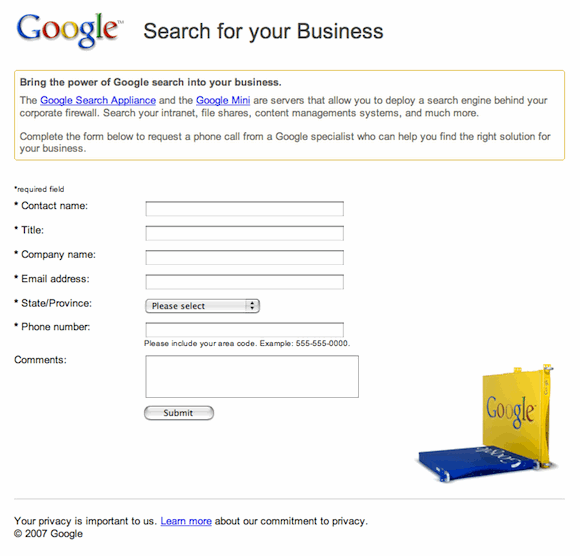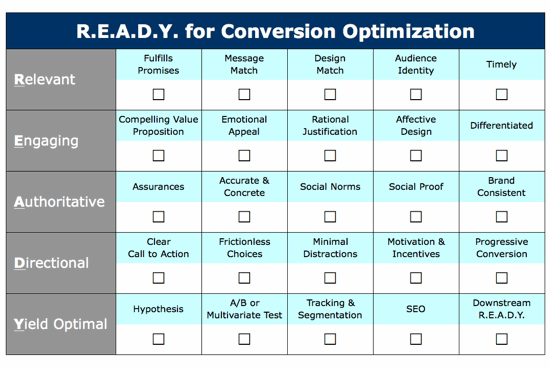Landing Pages 3.0: How Content & Context Plays A More Meaningful Role
Landing pages have evolved a lot over the past five years. Back in 2007, landing pages were almost cliché — what I would call Landing Pages 1.0. Take this example from Google — yes, Google — with the prototypical structure: a headline, a short description or some bullets, a small image (“hero shot”), and a […]
Landing pages have evolved a lot over the past five years.
Back in 2007, landing pages were almost cliché — what I would call Landing Pages 1.0. Take this example from Google — yes, Google — with the prototypical structure: a headline, a short description or some bullets, a small image (“hero shot”), and a form.

Most of the fields on the form were required. The “submit” button was still in vogue. And the payoff for filling out the form? A phone call from a sales rep.
Okay, so this first generation of landing pages wasn’t very good. But such pages were effective enough in lead generation that they got the ball rolling. Marketers started to wonder what they could do to make landing pages better.
Landing Pages 2.0: The Beginning Of Best Practices
To me, 2008 was the year when a new generation of landing pages took off — call it Landing Pages 2.0.
Two great books came out that year, Landing Page Optimization by Tim Ash and Always Be Testing by Bryan Eisenberg, and launched what I would characterize as the “best practices” era of landing pages.
Best practices were things that everyone using landing pages could — or should — follow. They included:
- A/B and multivariate (MVT) testing — test, test, test your ideas
- “message match” continuity between ads/emails and their landing pages
- shorter and friendlier forms with better calls-to-action (CTAs)
- emphasis on text content (not Flash!) to improve SEO and quality scores
- “social proof” with logos, awards, certifications, testimonials, etc.
A year and a half ago, I put together the READY Conversion Optimization Framework as a broad summary of the most universal landing page best practices of the time:
Landing pages were definitely getting better at persuading people to convert. But for the most part, they were still somewhat formulaic — just following a better, richer formula.
Landing Pages 3.0: Beyond Best Practices
In the past year, I believe there’s been another qualitative jump to a new generation of landing pages — Landing Pages 3.0.
This generational shift was fueled in part by the creative explosion of content marketing, the customer-centricity of social media, and the impressive advancements in Web interfaces due to HTML5, CSS3, and a Renaissance of robust Javascript packages and frameworks.
It was also motivated in part by senior marketers — not just the paid search team — realizing that landing pages and websites were becoming the primary touchpoints by which prospects and customers assessed their brands. The rally of digital “customer experience” has brought much needed executive attention to the proverbial online marketing funnel.
But as much as anything, this metamorphosis is the result of conversion optimization maturing as a marketing discipline.
This new generation is ready to move beyond “best practices.”
Whereas the height of Landing Pages 2.0 was an ever-expanding list of rules and rubrics for implementing good landing pages, marketers who have graduated to a Landing Pages 3.0 mindset have outgrown such checklists and cheat sheets.
Instead, they’re now driving conversion programs from a higher set of principles:
- Deliver meaningful, context-relevant content
- Present that content with an engaging, affective design
- Offer a compelling, but not coercive, “next step” to take
Like an architect who has completed his or her basic design studio courses, practiced and perfected the fundamentals, who is now ready to start breaking the cookie-cutter “rules” in pursuit of more impressive and imaginative ideas. Or like a musician who has mastered scales, riffs, and progressions — hours and hours of the mechanics of their instrument — who is now ready to improvise and jam with the pros.
Landing Page 3.0 marketers have studied best practices, absorbed them into their thinking, but they’re now ready to synthesize new creative ideas of their own — unafraid to break the “rules” to deliver remarkable experiences to their audience.
An Example Of Landing Pages 3.0
I was recently struck by this post-“best practices” era when looking at a landing page for an online game called Dragons of Atlantis:
It violates several “best practices” from Landing Pages 2.0. It uses large images — in the background, in the foreground, in pop-up lightboxes. It actually uses a slide show of images — gasp! — in that main window, rotating one after another every few seconds. (I can think of at least one Landing Pages 2.0 consultant who would be apoplectic at that thought.)
But in my opinion, that’s what works in this context: the images sell the experience of the game itself.
All the SEO-optimized text in the world couldn’t hold a candle to those big, crisp slices of game screens. They’re lightly annotated just enough to communicate the essence of game play. The rotator tells a story with them in a succinct and captivating way.
It may take a second or two for this page to load on a fast connection, but if it enchants respondents enough to sign-up, that’s a price well worth paying.
And to be fair, it’s smart in the way it’s breaking those rules. Those large images are being served via a content delivery network (CDN), and the image rotator is not Flash-based but driven by lightweight Javascript.
Meanwhile, other Landing Page 2.0 rules are still observed: short form, clear call-to-action, the highlighted “free to play” value proposition, a strategic sliver of social proof. It’s a hybrid of solid fundamentals and creative departures from the old school.
That sums up the essence of what I believe Landing Pages 3.0 are all about. The shackles are disintegrating and the mandate to impact your audience with something extraordinary has been issued from the highest levels.
How will you answer the call?
Disclosure: Kabam, the makers of Dragons of Atlantis, is a customer of my company’s software. They were a handy example, however, there’s nothing about this Landing Pages 3.0 gestalt that is unique to or dependent on our software.
Contributing authors are invited to create content for Search Engine Land and are chosen for their expertise and contribution to the search community. Our contributors work under the oversight of the editorial staff and contributions are checked for quality and relevance to our readers. The opinions they express are their own.
Related stories
New on Search Engine Land

